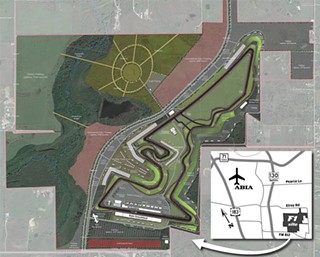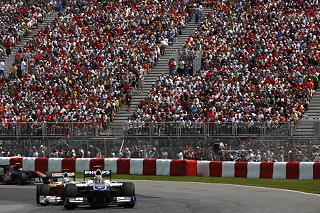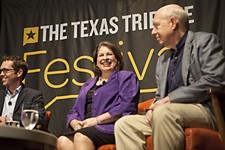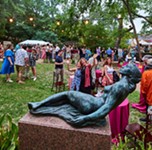How Do You Formulate a Grand Prix?
Distilling the volatile chemistry of high-speed development, Austin, and Formula One racing
By Richard Whittaker, Fri., Nov. 19, 2010
Five months ago, Austinites heard the surprising announcement that Formula One motor racing is coming to town. With the first major council vote scheduled for Nov. 18, the developers, partners, and local government are beginning to tackle the complicated and potentially daunting reality of turning a big dream into a concrete reality, starting with the construction of a purpose-built racetrack.
But the track is only part of what's now planned for the 900-acre tract in southeastern Travis County, and the sum of what's proposed is quite ambitious. As Formula One United States Grand Prix Chair Tavo Hellmund said at a recent luncheon of the Real Estate Council of Austin, "Formula One is really just the crown jewel of what this multifunctional facility's going to be and what it can do for this area."
So far, a lot of the talk – including most of the satirical commentary – has placed the Monaco Grand Prix as the frame of reference. Monaco has been a mainstay on the grand prix calendar since 1929: A street circuit, it sends drivers hurtling across the length and breadth of the tiny principality. The glamour, the sparkling seas of the Mediterranean, the ancient architecture: In fact, it's hard to imagine a location less like what's planned for Austin.
The more likely model is the home of the British Grand Prix, Silverstone Circuit. Situated in a rural area, surrounded by small villages, and within driving distance of the nearest city, Silverstone has a lot in common with Elroy, the unincorporated community southeast of Austin that will house the F1 track. Even the road situation is similar: The M1 motorway, the UK's main north-south arterial, sits about 10 miles east, and the track site is accessed by a smaller dual carriageway leading to a couple of small rural service roads. All in all, that's much like the situation in Elroy, where the 900-acre site lies next to the still underused Highway 130 toll road and between two smaller access roads, FM 812 and Elroy Road.* The Austin site arguably has better airport access: Austin-Bergstrom International Airport is only seven miles northwest of the site, compared to a 50-mile drive from Silverstone to Birmingham Airport.
The core purpose of the Austin facility, as at Silverstone, will be Formula One, which is also a massive part of the economic appeal. A grand prix race, unlike a football game, is not a one-day event but instead spans a long weekend, from open testing on Friday through to the post-race celebrations on Sunday. The Austin F1 group estimates 300,000 visitors across the weekend, including 120,000 for race day, and while the promoters hope to attract crowds from across Texas, many fans will travel longer distances and stay for up to a week. As project attorney Richard Suttle said at a recent meeting of the city's Environmental Board, "That translates into sales tax, hotel tax, alcohol tax, rental car tax, in addition to the property taxes that will be generated by this project in this area."
However, no track has ever turned a profit from a single race. That's why Silverstone plans to host three major events in the next year: the Formula 1 Santander British Grand Prix, the Formula Ford 1600 Walter Hayes Trophy, and, for motorbike enthusiasts, the MotoGP AirAsia British Grand Prix. The current plan calls for four to five racing events a year at the Austin site. The appeal for their organizers, Hellmund argued, will be the track itself. All competitive motor-racing tracks are graded by the Fédération Internationale de l'Automobile (FIA), the ruling body for motor sports, on a scale of 1 to 5. Due to the extraordinary physical and safety demands of F1 racing, only "grade 1" tracks are allowed to host a grand prix; despite their world-class reputations, even the Indianapolis Motor Speedway and Daytona International Speedway are "grade 2." By creating a top-tier track, Hellmund said, "it will also have safety features that, hopefully, we won't have to do any upgrades for 30 years."
Beyond the Checkered Flags
Nevertheless, even big races will only fill the site for a few weekends a year, so the quest remains to fill the rest of the calendar. On Sept. 21, Hellmund's team unveiled the facility's conceptual plan, giving the first real insight into the business model. Aside from the racetrack, permanent stands, and LEED-certified green offices, the design includes a kart track, a motor sports driving club, and a driver/riding experience seminar building. Much like Silverstone, which offers on- and off-road driving packages, the idea is to attract motor sports fans and amateur racers to the facility all year round.
Yet it's what's planned away from the track that could have the greatest long-term impact. In technological terms, Formula One is akin to the space race. It may seem hard to explain spending all that money to make one person go really, really fast, but the value of the spin-off technology can be massive. That's why Hellmund and his group are beginning to fill out plans for a "research and innovation" campus. He said: "Our goal here is to not just do a race. Obviously, it will be our crown jewel for the first two or three years, but as we build this, as we envision it, then someone will be driving down 130 and see the signs to this facility and they'll look over and say, 'That's where the blankety-blank complex is, oh, and by the way, that's where they hold the U.S. Grand Prix.' We realize that, for the first few years, it'll be the other way around, but if we do it right, that's the way it should be."

Again, Silverstone provides a model. That facility has 58 businesses in its business park, many of them high tech research and development firms, and there are plans for a major expansion in the next few years. "We're not talking downtown London," Hellmund said. "This is out in the middle of nowhere. These businesses all located there because of the appeal of being near the pinnacle of technology." According to Hellmund, the Austin project team has "already had aeronautical companies calling us, several manufacturers, and a lot of engineering firms." Certain names have come up as interested parties. Williams Hybrid Power Limited – a spin-off firm of the Williams F1 team – is known to be looking for a manufacturing and testing facility for its flywheel energy storage technology, and its staff have visited Austin twice. There has also been active discussion of forming R&D partnerships with the University of Texas at Austin, at a moment when the university has made a commitment to expanding commercialization of its research. Hellmund said, "UT early on embraced that this could do for them exactly what the Olympics did for Georgia Tech."
The mixed-use proposal already has one major endorsement, from FIA Senate President Nick Craw. He visited the site in October and said: "I think it's a very good plan and a very solid business model. They've set the bar pretty high."
All this said, negotiations remain in their preliminary stages, and while the track needs to be ready by June 2012, the science and business park is between three and five years down the line. No one is talking about inking any contracts quite yet, and the long-term preparation has just begun. Project spokesman Adam Goldman said, "The moment the paper's been filed and we turn dirt, that's when we can put a little more energy, time, and focus into: 'OK, what's this innovation and tech center look like? What will the marketing deals look like? What's the involvement with UT?'"
So that means that nothing happens with the research park or the kart track or any other amenities until the track itself breaks ground. Conversely, while the other elements of the project can wait, track construction will be held to a very strict timeline, established by FIA and Formula One Management. Attorney Suttle said, "We've been told we have to be ready for June 2012." To hit that deadline, with a projected 18-month building schedule, means breaking ground in December of this year. Ergo, a lot of contracts need signing: The developers have already signed up German architects Tilke GmbH as track designers, the local office of national engineering firm Terracon Consultants has been boring soil samples for months, and Austin-based Horizon Environmental Services Inc. has been retained as environmental engineers to the project. That still leaves a general contractor, a fan-area architect, and dozens of other contracts in progress.
It also means a lot of planning paperwork.
The November Rush
As with any development of this size, there are a lot of players and several regulatory agencies at the table. The project site is beyond city limits but within Austin's extraterritorial jurisdiction – the city of Austin, Travis County, and the Texas Department of Transportation are all heavily involved with the permitting process, and the U.S. Army Corps of Engineers has an interest in whether any changes on the ground would be governed by federal flood plain regulations. City spokesman Kyle Carvell said, "That can breed a lot of ambiguity about who's doing what, who's involved in reviewing what, and where we're at in the entire process." To ensure that the city is speaking with a unified voice, he said, "We've even devised an internal team made up of staff from different departments that have different specializations to consolidate our efforts and make sure that we respond to the community, to the media, and also to make sure the process is as seamless as possible."
With the December start date seemingly set in stone, that makes November a pivotal and busy month for the project. The first major permit vote came last week, on Nov. 3, when the Environmental Board unanimously approved a variance allowing a maximum 36-foot cut and 26-foot fill as part of the grading process to prepare the land for the track. The board's agreement came with recommendations from staff and amendments from the commissioners, requesting additional tree-planting and creek protections. On Tuesday, that proposal was approved 5-1 by the Zoning and Platting Commission, and from there it will go to City Council for final approval. If that all goes smoothly, then the grading can begin in December. City staff's response when asked whether that's a realistic target was simple: "The December start date looks manageable."
However, that would be just the first of a slew of permits that will be working their way through the city planning process. The general site plan will be submitted after grading begins, and the developers have already requested a permit to relocate two old gas lines (a 24-inch gas main and a 4-inch liquid gas line) from under the track to elsewhere within the property. The project is erring on the side of caution in this opening stage; Suttle told the Environmental Board that planners are classifying the project's parking areas, actually artificially reinforced grass, as impervious cover, just in case there is a need to go back later and make modifications, like adding extra drainage gravel. Since a big part of the appeal of building an Austin track is to keep the facility as green as possible, he said, the more grass, the better.
Project spokesman Goldman said: "The focus right now is twofold. It's, 'Get those permits in place,' and at the same time it's, 'Let's nail down all the plans on the construction side.'" That seeming ambiguity is not, he insisted, evasiveness or sign of some hidden agenda but rather of how big and long-term a project this is. Once the track construction is up and running and priorities are in place, then developers can aggressively court tenants and partners. Goldman said, "If we don't have those deals set today, that doesn't affect the Formula One Grand Prix."

Although the schedule calls for the track to be ready by June 2012, that doesn't necessarily confirm when the flag drops on the first race. The F1 calendar isn't formalized until December of the prior year, meaning that the exact date for the Austin event won't be known until December 2011. The 19-date 2010 calendar ran from March to November; if the plan is for a June 2012 start date, that would put the U.S. Grand Prix close to the 2010 date for Montreal's Grand Prix du Canada. There has been speculation that there could be major shifts to the calendar, pushing the races in the U.S., Canada, and Brazil (normally held in November) closer together. It's not unheard of for races to be moved around (for example, China switched from October in 2008 to April in 2009), but it's more normal for races to only shift a couple of weeks in either direction. Suttle said: "Could it be later? Sure. But we've been told to be ready in June."
The Roads Most Traveled
That means moving fast to get all necessary information into the planning process. In September, Travis County commissioners raised a skeptical eye over the conditions of FM 812 and Pearce Lane, pondering whether they could possibly withstand the anticipated race-day rush. The F1 group's response was to hire two traffic management firms: U.S.-based Kimley-Horn and Associates, for expertise with Texas roads, supplemented by British transit expert Graham Lake-Grange, who wrote the traffic management and major incident plans for Silverstone and has overseen the transit needs of 13 British grand prix. Suttle said, "We're hoping that with the blend between the local guys and the folks from Silverstone, because that's the track most like where we are, we'll have a plan."
The initial county estimates were that it would take 12 hours to completely empty the site after a race. But the consultants are working on their own traffic study, Suttle said: "There's a very scientific number of cars per hour per lane that you can run through the system, and when you run that, it's just a formula. It's not like a football game where there's a kickoff and a final gun – it's an event that ebbs and flows over the course of the day." Suttle said he's confident that an updated model, using better data and implementing some traffic management techniques, will see that 12-hour figure decline to a fraction of that. That doesn't mean that upgrades to the two service roads are off the table; however, that will probably have more to do with the long-term plans for the innovation park than any individual race. Suttle said: "You don't build a road network for one or two events. You manage for those. What goes on after is when you build the roads. So it's probably chapter two."
So far, it's been the traffic issue, along with related environmental effects, that has sparked the largest and most focused public resistance. During the Nov. 2 Environmental Board meeting, opponents – including Austin Sierra Club Chair Chris Lehman, Del Valle Independent School District trustee Richard Franklin, and Stefan Wray, founder of the Concerned About Formula One (F1) Racing Coming to Austin Facebook group – all voiced concerns about potential pollution, especially air pollution, and the seeming contradiction of a "green city" like Austin promoting motor sports at all. Supporters countered that in comparison to other major local events, such as the Austin City Limits Music Festival, University of Texas football games, or South by Southwest, F1 will generate relatively less pollution (e.g., carbon emissions), and planners argue that the research aspects of the entire project in fact can produce groundbreaking environmental knowledge.
Slicing the Pie
However, the most immediate economic and political debate surrounds the potential for involvement by local minority-owned and women-owned business enterprises (aka "MBE/WBE") hoping to get a share of a project that could generate 1,500 construction jobs. While there are no general municipal rules about MBE/WBE participation in private projects, the F1 planners have already committed to one project that will require that they fulfill city bidding regulations. Back when the land was planned for the now-defunct Wandering Creek housing development, the city approved a "service extension" request, under which the city promises to reimburse a developer for utility construction costs such as water mains. The principle is that, while the developers get the initial value of providing water for their homebuyers, if they agree to oversize the pipes for later development in the area, the long-term benefits return to the city.
With long-term questions already being raised about how soon the facility might be pulled out of the extraterritorial jurisdiction as the city limits absorb it, and with the promise of some high-profile tenants in the business park, the city is considering investing $13 million in the project's water supply. On Nov. 10, the city's Water and Wastewater Commission voted 5-1 to back the revised request. It goes before council on Nov. 18 as two agenda items: $5 million for a 24-inch water pipe and a 36-inch water pipe and $8 million for a 30-inch wastewater pipe. A similar request worth about $11 million was approved by council in 2008 when the site was slated for 1,800 houses. Back then, it was $4 million for the two water pipes and $7 million for a 36-inch wastewater pipe.
According to Austin Water Assistant Director David Juarez, the difference is due to changes in the plans, including relocating the 24-inch water line along the site's internal roadway; as for the wastewater line, while the pipe is a smaller gauge, there will be more of it. He said, "The Wandering Creek site was smaller, so we're essentially adding another 3,000 liter-feet of line."
If approved by council, and if the developers remain in compliance with all terms of the deal, the reimbursement will come out of the utility's $250 million capital improvement projects fund. The city regularly deals with a large number of small requests, and while one this size only comes up every few years, Juarez said that it was not extraordinary in scale or nature. However, that doesn't deflate long-running concerns that such requests are simply developer subsidies.
Juarez countered that, since the site falls within the city's service area, the utility has always known that it would ultimately be responsible for extra lines in the area. While the request has accelerated those plans, he said, "We were looking to make those improvements in a 20- to 40-year time frame."
Part of the quid pro quo the city demands is that, like a city project, the reimbursement depends on adherence to the city's small-business rules. Suttle confirmed "[it] will be bid under the city's guidelines for MBE/WBE, so that will strictly comply."
The project has already hired one city-certified MBE/WBE contractor in Horizon Environmental Services Inc. But some advocates are pushing the city to ask broader questions about opportunities for small-business involvement now, rather than leaving it to the developers' good intentions. Paul Saldaña represents the U.S. Hispanic Contractors Association. "For over 90 days," he says, "we have been trying to get a meeting with the Formula One folks to look at potential contracting possibilities." His concern springs from the $25 million currently penciled in by the state out of the Major Events Trust Fund. That money, paid to the project to help cover hosting fees and repaid out of anticipated increased sales taxes, comes from the same fund used to attract to Texas the 2006 and 2010 NBA All-Star games and the 2005 and 2011 Super Bowls.
As the legislation stands, Saldaña argues, the city could be asked to contribute $1 for every $6.25 the state contributes. "The way the legislation is written," he said, "a lot of that stuff would happen at the tail-end." Saldaña's solution to remove any ambiguity would be a full briefing to council on all the issues; otherwise, he said, "The project will already have been built, and we'll have missed the opportunity for there to be [small-business involvement] goals attributed to both the design and the construction of the 900-acre master plan."
On Nov. 2, the city's MBE/WBE and Small Business Enterprise Procurement Program Advisory Committee met to discuss where its list of certified contractors may fit in. Committee Chair Adrian Lopez Neely said, "Right now, we're just investigating what the project is like, and if there's any city involvement that we follow the MBE/WBE ordinance." But it's a private project, and while his committee will look for regular updates from staff, the review won't reflect the same transparency rules as city construction. With so many moving parts and the project evolving and expanding for years to come, he said, "It's going to be difficult to know what the stages are until they apply for a permit, so you have to keep a close eye on each permit request."
According to the city's MBE/WBE staff, the committee discussed the F1 project after it was contacted by a member of the public requesting a hearing. That person? Paul Saldaña, who also organized a meeting with the mayor's office on Nov. 1. He's unabashed about pushing for the best deal possible for his clients. He said, "If you have guys coming from Germany and overseas, and they're going to benefit from the taxpayers' dime, why shouldn't local small contractors and businesses also have an opportunity to benefit?"
According to Assistant City Manager Rudy Garza, the project management has indeed been proactive on MBE/WBE issues, contacting him in June with a long list of questions. He said: "We probably spent the first couple of months orienting them with how our program works. After that, they wanted to learn how to be successful, so we talked about different outreach strategies." The key, he said, will be finding ways to structure the project to allow for small businesses and minority- and women-owned businesses to bid for suitably sized components. Some big contracts have already proceeded and were out of the scope of the local firms anyway; for example, while some F1 fans may grumble about track designers Tilke GmbH, the German architects are one of very few firms globally with the experience and technical know-how to design a grade-1 raceway. Garza said: "It's clear that, for our certified contractors, it's very difficult for them to have the capacity to build a 20-, 30-million-dollar facility. So what we do on our own projects is to package different scopes of work in a manner that makes sense for the project and also allows for more opportunities."
Until all the trackside designs are finalized and the general contractor is hired, it will be uncertain how those opportunities can be structured. To help them in that task, on Nov. 10 the local F1 team announced it had hired as its MBE/WBE consultants the Austin-based firm of Haynes-Eaglin-Waters, headed by Cloteal Haynes, a former city planning commissioner and former board member of the Austin Black Contractors Association. In a statement, the U.S. Hispanic Contractors Association responded, "The commitment and actions taken by Formula One to retain an outreach consultant is a step in the right direction and we remain optimistic." The important coda, Garza added, is that anything the project commits to beyond mandates (like those for the water mains) remains voluntary. He said: "This cannot and will not be a 100-percent transparent project and be treated like a city project. It just can't happen. So that may create some frustration for some folks." Since the entire construction will be privately funded, he added, "the expectations really should be appropriate for the type of project that it is."
Like the traffic and other general planning issues, the MBE/WBE debate is one more structural and procedural hurdle the F1 project team will have to clear. It certainly won't be the last one. Lopez Neely said it was natural for his advisory committee to get involved, because the pure scale of the endeavor is of a size that has rarely been seen in Austin. "I'm sure every board or commission is looking at it. It's a high-profile project," he said.
It's also one that would place Austin firmly on an international stage. As the F1 group has pointed out, just the TV coverage of the race alone will effectively be a three-hour advertisement for the city, to be seen by an estimated 600 million people worldwide. That's about half the audience for the FIFA World Cup, but six times that of the Super Bowl.
The initial F1 contract is for 10 years; Hellmund has said that he'd like the facility to be up and running for at least 40. Suttle summed up the learning curve the city faces on both the task at hand and the potential benefits. He said: "On a scale of 1 to 10, 10 being the most educated? I think we're on about a point-five – just on what Formula One is."
*[Editor's note: The original version of this story mistakenly located the F1 site next to Pearce Lane rather than Elroy Road.]Got something to say on the subject? Send a letter to the editor.












